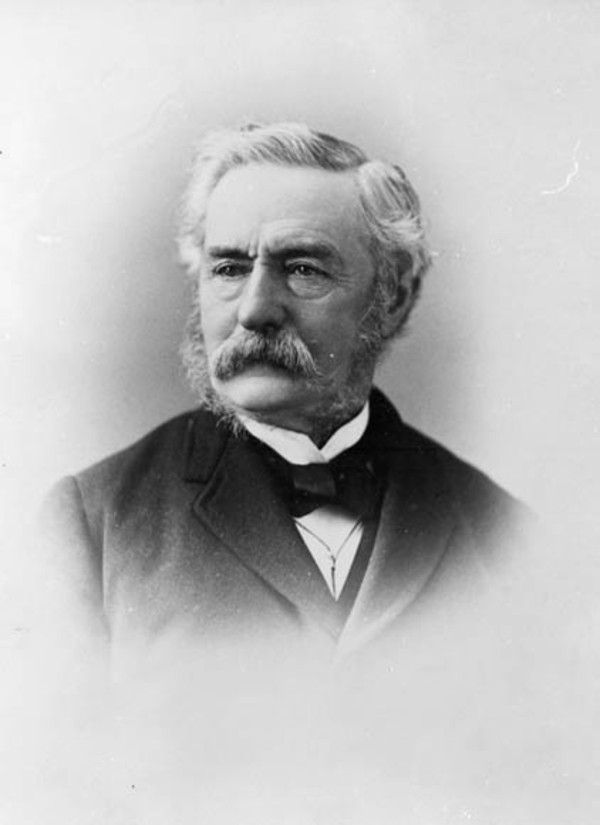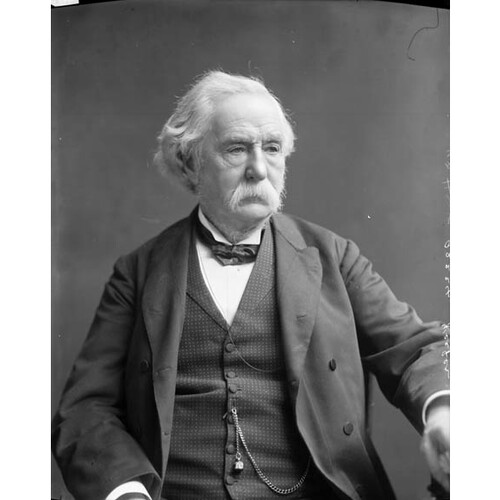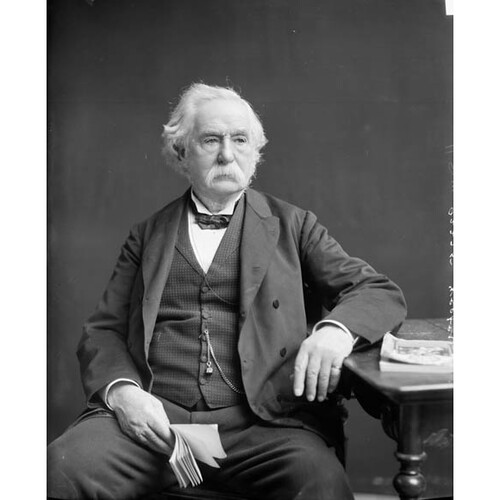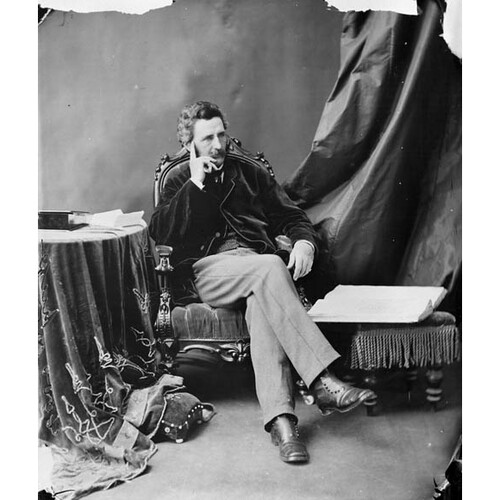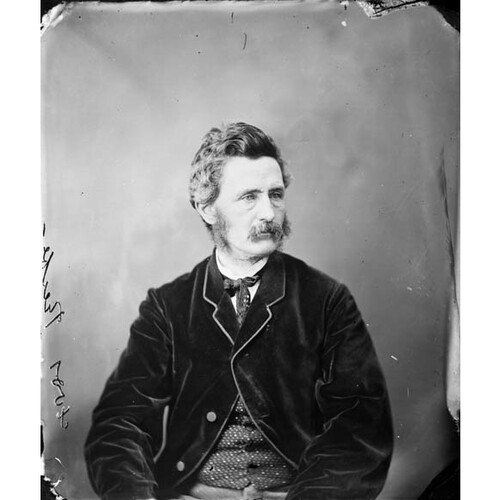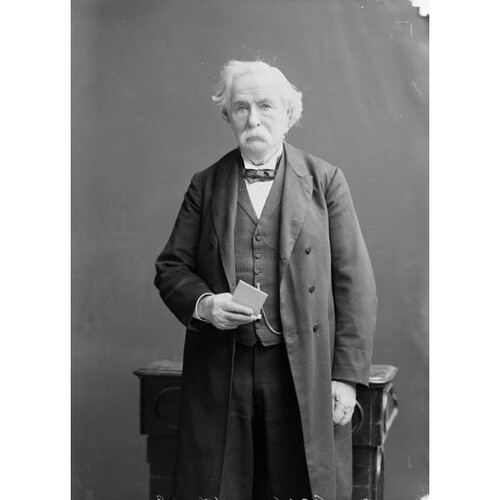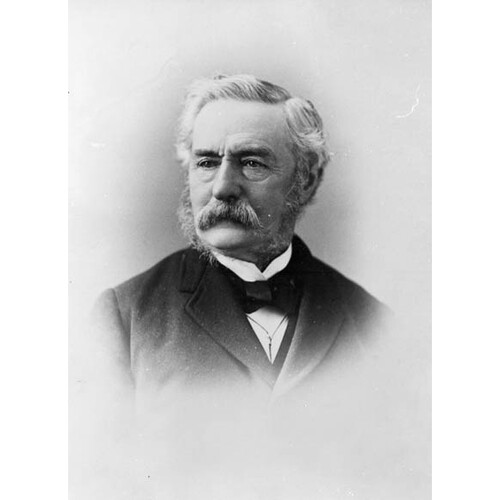As part of the funding agreement between the Dictionary of Canadian Biography and the Canadian Museum of History, we invite readers to take part in a short survey.
KEEFER, THOMAS COLTRIN, engineer, author, and businessman; b. 4 Nov. 1821 in Thorold Township, Upper Canada, eighth son of George Keefer* and Jane Emory, née McBride; m. first 27 Sept. 1848 Elizabeth McKay (d. 1870) in New Edinburgh (Ottawa), and they had three sons and four daughters; m. secondly 26 June 1873 Annie MacKinnon, née McKay (d. 1906), in Rockcliffe (Rockcliffe Park), Ont.; they had no children; d. there 7 Jan. 1915.
Like his elder half-brother Samuel Keefer*, Thomas Keefer was born to engineering. His father, through commercial association with William Hamilton Merritt*, was first president of the Welland Canal Company. In the 1820s and 1830s the Keefer children, and there were 14 of them, grew up immersed in the ceaseless activity, disasters, and tentative triumphs of frontier canal building.
Keefer received his formal education at Grantham Academy in St Catharines and Upper Canada College in Toronto. Upon graduation in 1838 he worked as an apprentice engineer on the Erie Canal in New York State, at the time the leading project on the continent for schooling engineers. From 1840 to 1845 he practised as an assistant engineer on the Welland Canal, which was then being reconstructed with public money. Through the influence of Samuel, who had become chief engineer of the Board of Works of the Province of Canada, Thomas was appointed engineer in charge of the timber slides and river improvements at Bytown (Ottawa) in 1845. Four years later he was transferred to the St Lawrence River improvements, on which he would work for about two years.
Keefer’s marriage in 1848 to Elizabeth McKay, daughter of Thomas McKay*, a legislative councillor and one of Bytown’s wealthiest landowners and industrialists, brought him the financial security necessary to preach and practise engineering in a fractious environment. The McKay fortune, which Keefer administered following his father-in-law’s death in 1855, meant that he would never have to scramble for work. He could, when occasion required, be above the political jockeying for place in an engineering community riven with jealousies and conflicting ambitions. But he was not by nature a bystander. He fervently believed that the prosperity and spiritual well-being of the population would be wonderfully advanced if technology could be applied to the abundant resources of the country under a wise commercial policy – and he was impatient to proceed with a minimum of political interference or financial trickery. Above all, he maintained, Canada needed transportation improvements. The St Lawrence pointed the direction westward. It was for man to improve upon this avenue with the new technology of masonry, steam, and iron. But this goal would require concerted effort and public investment. These convictions formed the basis of the two pamphlets published in Montreal and Toronto in 1850, Philosophy of railroads . . . and The canals of Canada . . . , with which Keefer burst into prominence.
Written at the behest of the Montreal and Lachine Rail-road, Philosophy stands as one of the most rousing hymns to railway promotion ever penned. Its immediate object was to turn Montreal’s attention away from local railways and projects connecting the city by rail to seaboard ports towards a strategic linkage with Toronto, thereby allowing Montreal to outdistance its American rivals for control of the interior trade. But in its rolling cadences and literary allusions, Keefer’s prose transcended the immediate commercial objectives of his Montreal patrons to make a soaring general argument linking railways to the material improvement and moral perfection of man. For this reason the pamphlet was reprinted four times, translated into French, and in various forms employed in the promotions of several Maritime and New England projects.
Canals, which won first prize in the essay competition sponsored by Governor Lord Elgin [Bruce*] to celebrate the completion of the provincial canal system, set forth in equally compelling prose the idea of a commercial empire of the St Lawrence. The Great Lakes basin had the capacity to produce vast quantities of foodstuffs and raw materials and to consume impressive quantities of manufactures. Newly improved with canals, the St Lawrence provided the shortest direct route between this richly endowed granary and the markets of Europe. The merchants and communities along the route, most notably Montreal, stood to gain if the improvements could be built upon, the river itself properly dredged and maintained, and an appropriate commercial policy developed. But Montreal would have to be aggressive: in a competitive situation Upper Canadians had choices and if Montrealers hoped to capture their trade, they would have to do so with better service rather than restrictive legislation.
Writing in the turbulent year 1849, which was marked by the rebellion losses riots and the annexationist movement [see Bruce], Keefer could not avoid the trade question. Now that the policy of imperial preferences, upon which canal construction was predicated, had been repudiated by Britain, what ought to be Canada’s proper course? Keefer proposed the pursuit of qualified free trade between Canada and the United States in natural products and a policy of moderate protection “for those manufactures only which require little manual labour, and of which we produce raw materials.” Free trade in natural products would maximize the utility of the canal system while selective protection would promote gradual industrialization.
Through the patronage of W. H. Merritt, commissioner of public works in the Baldwin*–La Fontaine* government, and John Young*, Montreal’s harbour commissioner, Keefer became the engineer of Montreal metropolitanism. In practice he was consulting engineer in 1853–55 on the city’s harbour and shipchannel. During the early 1850s his pamphlets on river and harbour improvements, his site plan for a bridge across the St Lawrence near Montreal, his public lectures on the agricultural and natural resources of the hinterland, and his preliminary surveys of railways towards Toronto and Ottawa were intended to demonstrate how steam and iron could be made to serve Montreal’s commercial ambitions. In the same period Keefer also promoted Merritt’s broader objectives by compiling trade statistics and marshalling arguments on behalf of reciprocity with the United States in collaboration with Israel de Wolfe Andrews*.
Though considered a leading propagandist for railways, Keefer was greatly disappointed in his ambition to take charge of the construction of the lines he had projected. He criticized co-premier Francis Hincks*’s policy of handing the Grand Trunk project over to British contractors in 1852. He fell out with the Grand Trunk over unpaid bills for his preparatory work and was passed over as chief engineer in favour of Walter Shanly*. The contractors, Peto, Brassey, Jackson, and Betts, had their own ideas about how and where to build the line as well as about the subservient role engineers were to play in its construction. On account of his partisanship, the government rejected Keefer as an investigator of subsequent Grand Trunk difficulties. Shunted to the sidelines, he turned from an advocate of railways into an avenging critic of promoters’ waste and political corruption by such entrepreneurs as Samuel Zimmerman*. But he never lost his faith in railways themselves. He was a public proponent from at least 1869 of the idea of a Pacific railway, his presidential address in 1888 to the American Society of Civil Engineers described the engineering wonders of the newly completed Canadian Pacific Railway, and in his turn-of-the-century presidential address to the Royal Society of Canada he envisioned a country linked by a system of high-speed electric railways.
Keefer did build waterworks. These now mundane utilities exemplified the near-miraculous civilizing powers of 19th-century engineering. Intended primarily as a means of controlling fires, waterworks also provided abundant quantities of clean water to inhabitants. Thus in one stroke the twin scourges of urban life – fire and disease – were brought under greater control. And, with reductions in fire-insurance premiums, the works could be said to pay for themselves. By building infrastructure of this kind, municipal corporations could transcend pettiness and immobilizing factionalism and create a civic culture that was more than the sum of its parts.
Keefer’s plan for Montreal’s waterworks, commissioned in 1853, went one step further. Guided by the engineer’s genius, nature would do all of the work. He proposed to use the power of the descending waters of the St Lawrence to pump water up to reservoirs on Mount Royal which in turn would pressurize water mains in the city below. This controversial system worked for a time, but Montreal quickly outgrew its capacity and in the wintertime ice in the fore-bays of the intakes reduced its efficiency. When the system was expanded in the late 1860s more reliable steam pumps were installed.
Following the initial success of the Montreal works, Keefer was in great demand as a consultant for similar projects in other cities. Hamilton retained him to decide between three different plans to furnish water and then commissioned him to build its waterworks in 1857–59. This time Keefer chose steam pumps of the latest British design. Lovingly restored in the 1980s, these Woolf compound engines, built by John Gartshore in Dundas, Upper Canada, and Keefer’s elegant engine-house stand as a lasting monument to mid-Victorian civic initiative, technical ingenuity, and the noble concept of progress. Further work of this kind followed in Ottawa and other cities. An engraving of Keefer in the Canadian Illustrated News (Hamilton) of 26 Sept. 1863, showing him surrounded by his monuments – locks on the Welland Canal, a fire-hydrant, and the Victoria Bridge near Montreal (actually built by James Hodges*) – captures him at the apogee of his career. But the advancement of waterworks did not flow easily. Municipalities and ratepayers baulked at costs; partisanship bedevilled the choice of designs as well as contractors. Inevitably compromises and trade-offs had to be made. Cities rapidly outgrew the capacities of their systems, necessitating costly enlargements. Engineers competed ruthlessly for these opportunities, raged privately about delays, and bridled at the insult of rejection. Everywhere, however, the finality of fire drove the process forward. As Keefer noted in a mordant letter to an ally on Toronto City Council in 1856: “I see Hamilton Water Com[missioners] have adopted my report & plan in its integrity – but nothing can be considered decided until the bylaw is submitted to the Citizens – a few large fires will settle the matter both with them and you.”
Keefer’s growing reputation as an engineer and prophet of progress, combined with his Ottawa connections, opened another outlet for his talents as a publicist: Canadian presentations at world’s fairs. In 1851 and 1862 he assisted in the organization of exhibits for the expositions in London. Amidst fiscal adversity he achieved his greatest triumph as executive commissioner of Canada’s participation in the universal exposition in Paris in 1878, for which he was made a cmg by Queen Victoria and an officer of the French Legion of Honour. Through his energy Canada gained pride of place in the rotunda at the head of one of the three exhibit halls. There Keefer assembled a monumental four-storey “trophy,” an astonishing cross between a pagoda and a triumphal arch on which all the symbols of Canada were hung. On its four faces the trophy displayed the bounty of the fields, forests, mines, and seas. The balconies, inset with the coats of arms of the provinces and principal cities, were decorated with flags and bunting, buffalo and elk heads, ships’ wheels, agricultural implements, canoes, and other bric-à-brac. At ground level visitors were greeted by stuffed bears, baskets hanging from their fearsome jaws to collect calling cards. As this was the first time Canada had presented itself in Europe as an aspiring nation, Keefer, in the exhibitions and accompanying catalogue, sought to produce a vision of towering ambition, energetic citizenship within a leading British colony, and expansive, natural wealth in a new transcontinental dominion, a display which, in space, ingenuity, and interest, he claimed outshone that of the United States.
During his latter years Keefer devoted himself to the management of the McKay estate and the advancement of engineering as a profession. In 1873, in a somewhat unorthodox move for the time, he married his deceased wife’s widowed sister. This union consolidated his control over the McKay estate and its properties in and around Ottawa. In 1878 he established as his seat Rockliffe Manor House, a stone mansion on a wooded eminence overlooking the Ottawa River, an area that he subsequently had developed. In his capacity as real estate developer he served as president of the Ottawa City Passenger Railway Company (incorporated in 1866 with a perpetual franchise), a horse-drawn railway that connected Rockcliffe and New Edinburgh with the city centre. Curiously Keefer was reluctant to modernize the railway with the result that the city issued a franchise for a rival electric street railway. In 1894 his valuable operation was bought out by Thomas Ahearn* and Warren Young Soper, the proprietors of the new company.
As he approached 70, Keefer understandably tended to do less and less engineering, although the family firm flourished under the direction of his surviving son, Charles Henry. During the 1880s and 1890s Keefer found time to investigate ice problems and winter navigation on the St Lawrence, help adjudicate a dispute over engineering costs on the CPR, and survey the possibilities of providing more direct deep-water linkages between the St Lawrence and the Upper Lakes. He continued to promote canals, his first love, through membership from 1895 in the Canadian-American deep waterways commission. And, despite his age, he worked energetically to establish a profession of engineering. His bitter experiences in the 1850s with railway promoters and politicians had led him to rethink the role of the engineer. In a lecture at McGill College in Montreal in 1856 he argued for both an expansion in engineering education and a new status for the engineer. This call would be followed in 1857 by the creation of an engineering professorship at McGill. On the question of status, Keefer observed: “The engineer, though an indispensable agent, is generally a junior partner in the firm of Grab, Chisel & Co.” Instead, he proposed that engineers, like lawyers and doctors, should be a “self-sustaining” profession and that their technical advice should prevail over political and business considerations. It followed that they should be decently paid and accorded due social deference. Thus the Esq. and C.E. by which Keefer usually identified himself.
During the 1880s Keefer, along with his contemporaries and sometime rivals Casimir Stanislaus Gzowski*, Walter Shanly, and his half-brother Samuel, lent his name to the movement to organize Canadian engineers into a society to seek these goals. He was the founding president of the Canadian Society of Civil Engineers in 1887 and would remain active in it, serving again as president in 1897. He was the first Canadian to become president, in 1888, of the American Society of Civil Engineers and the only person to date to be president of both bodies. Counting himself among the conservatives in the movement for professionalization, he believed that professional status could be acquired only through accomplishment and not legislated. He also held that the CSCE should have educational goals, and that engineers should be learned gentlemen, not just technicians, and in the forefront of cultural, scholarly, and educational initiatives. He himself was made a fellow of the Royal Society of Canada in 1890 and its president in 1898–99. He received an honorary doctorate from McGill in 1905, and in 1912, in recognition of his long life of professional leadership, he was named an honorary member of the Institution of Civil Engineers of Great Britain.
Keefer lived out his model of professional achievement. He came from a distinguished family, added to its honour through his practice and international reputation, wielded a formidable pen, moved comfortably in the highest echelon of Canadian society, and was decorated abroad. He built useful works, but it was not given to him to build a great work. Perhaps for this reason the ultimate distinction of a knighthood eluded him.
Keefer’s last literary piece, written in his 90th year, was a homage to his mentor, W. H. Merritt. In The old Welland Canal and the man who made it (Ottawa, 1911), he recalled the thrill he had felt as a boy in 1829 watching two vessels, one British and one American, break through ice to open the Welland Canal. This recollection, with its symbols of technological triumph, continental economic integration, faith, human perseverance, and innocence, captures the main themes of Keefer’s life.
He died in 1915 at his beloved Rockliffe Manor House, predeceased by his second wife and three of his children, and is buried in the family vault at Beechwood Cemetery. He left an estate worth $610,000.
Forty-nine pamphlets, essays, and reports by T. C. Keefer, including several reprints and French editions, have been made available on microfiche by the CIHM and are listed in its Reg. A number of additional items appear in Science and technology biblio. (Richardson and MacDonald), and in the partial bibliography of Keefer’s publications up to 1893 in RSC, Trans., 1st ser., 12 (1894), proc.: 46. The main collections of original pamphlets are to be found in the MTRL and the library of the NA. Several of Keefer’s early railway pamphlets have been reissued with a critical introduction by H. V. Nelles as Philosophy of railroads and other essays (Toronto and Buffalo, N.Y., 1972).
AO, F 647; RG 22-354, no.7450. MTRL, SC, William Henderson papers. NA, MG 24, E1; MG 29, A2. St Andrew’s Presbyterian Church (Ottawa), RBMB (mfm, at NA). Gazette (Montreal), 6 April, 12, 14 July 1869; 22 Jan., 2 Feb. 1870. Ottawa Citizen, 8, 11 Jan. 1915. H. G. J. Aitken, The Welland Canal Company: a study in Canadian enterprise (Cambridge, Mass., 1954). Christopher Armstrong and H. V. Nelles, Monopoly’s moment: the organization and regulation of Canadian utilities, 1830–1930 (Philadelphia, 1986). C. C. J. Bond, City on the Ottawa: a detailed historical guide to Ottawa, the capital of Canada (Ottawa, 1967). Can., Parl., Sessional papers, 1891, no.9, app.18; app.19: 21. Canadian men and women of the time (Morgan; 1898 and 1912). Canadian Soc. of Civil Engineers, Charter, by-laws, and list of members (Montreal, 1887); Trans. (Montreal), 2 (1888): 9–44. Cyclopædia of Canadian biog. (Rose and Charlesworth), vol.1. Michelle Greenwald et al., The Welland canals: historical resource analysis and preservation alternatives (2nd rev. ed., Toronto, 1979). I. W. D. Hecht, “Israel D. Andrews and the Reciprocity Treaty of 1854: a reappraisal,” CHR, 44 (1963): 313–29. J. P. Heisler, “The canals of Canada,” Canadian Historic Sites: Occasional Papers in Archaeology and Hist. (Ottawa), no.8 (1973). William and E. M. James, “A sufficient quantity of pure and wholesome water”: the story of Hamilton’s Old Pumphouse (London, Ont., 1978). Robert Keefer, Memoirs of the Keefer family (Norwood, Ont., 1935). Marriage notices of Ontario, comp. W. D. Reid, [ed. T. B. Wilson] (Lambertville, N.J., 1980), 252. D. C. Masters, “T. C. Keefer and the development of Canadian transportation,” CHA, Report, 1940: 36–44. J. R. Millard, The master spirit of the age: Canadian engineers and the politics of professionalism, 1887–1922 (Toronto, 1988). H. J. Morgan, Sketches of celebrated Canadians . . . (Quebec and London, 1862; repr. Montreal, 1865). Nelles, Politics of development. Dianne Newell and Ralph Greenhill, Survivals: aspects of industrial archaeology in Ontario (Erin, Ont., 1989). G. A. Rawlyk, “Thomas Coltrin Keefer and the St. Lawrence–Great Lakes commercial system,” Inland Seas (Cleveland, Ohio), 19 (1963): 190–94. RSC, Trans., 3rd ser., 9 (1915), proc.: xi–xii and photo facing p.x.
Cite This Article
H. V. Nelles, “KEEFER, THOMAS COLTRIN,” in Dictionary of Canadian Biography, vol. 14, University of Toronto/Université Laval, 2003–, accessed March 29, 2025, https://www.biographi.ca/en/bio/keefer_thomas_coltrin_14E.html.
The citation above shows the format for footnotes and endnotes according to the Chicago manual of style (16th edition). Information to be used in other citation formats:
| Permalink: | https://www.biographi.ca/en/bio/keefer_thomas_coltrin_14E.html |
| Author of Article: | H. V. Nelles |
| Title of Article: | KEEFER, THOMAS COLTRIN |
| Publication Name: | Dictionary of Canadian Biography, vol. 14 |
| Publisher: | University of Toronto/Université Laval |
| Year of revision: | 1998 |
| Access Date: | March 29, 2025 |


